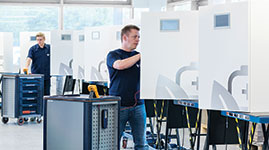Energy trading goes peer-to-peer
24 February 2016
Editor's Choice
Power Electronics / Power Management
By Brett van den Bosch
South Africa is not the only country suffering from electricity shortages. Even in the most developed nations, energy grids are groaning under the weight of growing and ever more power-hungry populations. The search for solutions to the problem is sparking something of a revolution in the way large-scale energy is generated, distributed and stored.
The first trend leading the charge is peer-to-peer energy trading, which establishes a mechanism for the ‘haves’ to sell power to the ‘have nots’ over existing power utility grids. This essentially takes the form of a matchmaking service, pairing energy consumers with suppliers in exchange for a fee. Examples of distributed renewables and smart grid technologies such as this have begun to crop up around the world.
In the UK, the company Open Utility has set up Piclo, a marketplace that gives generators and consumers control over their energy by showing where electricity comes from, what it costs and how those costs change over time. The service matches energy supply and demand preferences every half an hour, and trades exclusively in renewable electricity.
Dutch platform Vandebron charges consumers a monthly fee to contract directly with suppliers of clean energy for a set amount of power over a set amount of time. Currently boasting more than 38 000 subscribers, it allows consumers to choose their specific energy supplier, while producers get to name their price.
In parallel with these market dynamics, the continuous development and improvement of battery technologies is providing more efficient means of storing electricity. The most prominent exponent of this evolution to hit the market thus far is Tesla’s Powerwall, a home battery that charges using electricity generated from solar panels, or when utility rates are low, and then turns provider to power the home in the evening.
Final inspection of Sonnenbatterie’s ‘eco’ energy storage system.
Now German company Sonnenbatterie is connecting the strands by offering not only a virtual platform through which renewable energy can be bought and sold, but also a dedicated facility with batteries that store the energy and control its ebb and flow in harmony with the power grid – sort of like a server farm, but for electricity instead of data.
On the home front, the South African Department of Energy’s ‘Renewable Energy Independent Power Producer Procurement Programme’ aims for renewable energy to contribute 10 000 GWh, predicated on the estimation that a minimum of 3725 MW is required to ensure the continued uninterrupted supply of electricity.
While this programme is playing some part in incentivising the creation of renewable energy generating facilities, perhaps it’s time to open the way for a free market economy that can solve its own problems.
Further reading:
The ‘magic’ of photovoltaic cells
Editor's Choice
Everyone knows that solar generation converts sunlight to electricity, but what comprises a solar panel, and how do they actually work?
Read more...
Analysis of switch-mode power supply: inductor violations
Altron Arrow
Editor's Choice Power Electronics / Power Management
Common switch-mode power supply (SMPS) design errors are discussed, and their appropriate rectification is specified, with details on complications that arise with the power stage design of DC-DC switching regulators.
Read more...
Bridging the gap between MCUs and MPUs
Future Electronics
Editor's Choice AI & ML
The Renesas RA8 series microcontrollers feature Arm Helium technology, which boosts the performance of DSP functions and of AI and machine learning algorithms.
Read more...
Accelerating the commercialisation of the 5G IoT markets
Altron Arrow
Editor's Choice Telecoms, Datacoms, Wireless, IoT
Fibocom unveils Non-Terrestrial Networks (NTN) module MA510-GL, enabling satellite and cellular connectivity to IoT applications.
Read more...
Hardware architectural options for artificial intelligence systems
NuVision Electronics
Editor's Choice AI & ML
With smart sensors creating data at an ever-increasing rate, it is becoming exponentially more difficult to consume and make sense of the data to extract relevant insight. This is providing the impetus behind the rapidly developing field of artificial intelligence.
Read more...
Demystifying quantum
Editor's Choice
Quantum, often called quantum mechanics, deals with the granular and fuzzy nature of the universe, and the physical behaviour of its smallest particles.
Read more...
Service excellence with attention to detail
Deman Manufacturing
Editor's Choice
The vision of industry pioneers Hugo de Bruyn and Charles Hauman led to the birth of Deman Manufacturing, a company that sets new standards for innovation and performance within the industry.
Read more...
What is an RF connector?
Spectrum Concepts
Editor's Choice Interconnection
If you look across the broader electromagnetic spectrum, the selection of the 3 kHz to 300 GHz frequency range for RF signals is a result of a balance between propagation characteristics, data transmission requirements, regulatory allocations, and the compatibility of electronic components and devices.
Read more...
Make your small asset tracker last longer
Altron Arrow
Editor's Choice Power Electronics / Power Management
This design solution reviews a typical asset tracking solution, and shows how the MAX3864x nanopower buck converter family, with its high efficiency and small size, enables longer battery life in small portables.
Read more...
The power of Matter
Editor's Choice Telecoms, Datacoms, Wireless, IoT
Matter offers a reliable, secure, seamless way to interconnect devices from different manufacturers, allowing a new level of interoperability to be enjoyed.
Read more...

